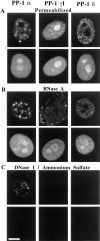Differential subcellular localization of protein phosphatase-1 alpha, gamma1, and delta isoforms during both interphase and mitosis in mammalian cells
- PMID: 9606212
- PMCID: PMC2137188
- DOI: 10.1083/jcb.141.5.1207
Differential subcellular localization of protein phosphatase-1 alpha, gamma1, and delta isoforms during both interphase and mitosis in mammalian cells
Abstract
Protein phosphatase-1 (PP-1) is involved in the regulation of numerous metabolic processes in mammalian cells. The major isoforms of PP-1, alpha, gamma1, and delta, have nearly identical catalytic domains, but they vary in sequence at their extreme NH2 and COOH termini. With specific antibodies raised against the unique COOH-terminal sequence of each isoform, we find that the three PP-1 isoforms are each expressed in all mammalian cells tested, but that they localize within these cells in a strikingly distinct and characteristic manner. Each isoform is present both within the cytoplasm and in the nucleus during interphase. Within the nucleus, PP-1 alpha associates with the nuclear matrix, PP-1 gamma1 concentrates in nucleoli in association with RNA, and PP-1 delta localizes to nonnucleolar whole chromatin. During mitosis, PP-1 alpha is localized to the centrosome, PP-1 gamma1 is associated with microtubules of the mitotic spindle, and PP-1 delta strongly associates with chromosomes. We conclude that PP-1 isoforms are targeted to strikingly distinct and independent sites in the cell, permitting unique and independent roles for each of the isoforms in regulating discrete cellular processes.
Figures







Similar articles
-
Protein phosphatase type 1 in mammalian cell mitosis: chromosomal localization and involvement in mitotic exit.J Cell Biol. 1992 Mar;116(6):1421-30. doi: 10.1083/jcb.116.6.1421. J Cell Biol. 1992. PMID: 1311712 Free PMC article.
-
Association of protein phosphatase-1delta with the retinoblastoma protein and reversible phosphatase activation in mitotic HeLa cells and in cells released from mitosis.Biochem Biophys Res Commun. 1997 Jun 27;235(3):704-8. doi: 10.1006/bbrc.1997.6886. Biochem Biophys Res Commun. 1997. PMID: 9207224
-
Differential cellular and subcellular localization of protein phosphatase 1 isoforms in brain.J Comp Neurol. 1999 Oct 25;413(3):373-84. J Comp Neurol. 1999. PMID: 10502246
-
Protein phosphatase-1 alpha, gamma 1, and delta: changes in phosphorylation and activity in mitotic HeLa cells and in cells released from the mitotic block.Arch Biochem Biophys. 1997 Apr 15;340(2):177-84. doi: 10.1006/abbi.1997.9889. Arch Biochem Biophys. 1997. PMID: 9143319
-
Analysis of the isoforms of protein phosphatase 1 (PP1) with polyclonal peptide antibodies.Methods Mol Biol. 1998;93:169-83. doi: 10.1385/0-89603-468-2:169. Methods Mol Biol. 1998. PMID: 9664535 No abstract available.
Cited by
-
Identification and characterization of a novel human PP1 phosphatase complex.J Biol Chem. 2010 Aug 6;285(32):24466-76. doi: 10.1074/jbc.M110.109801. Epub 2010 Jun 1. J Biol Chem. 2010. PMID: 20516061 Free PMC article.
-
The p53-targeting human phosphatase hCdc14A interacts with the Cdk1/cyclin B complex and is differentially expressed in human cancers.Mol Cancer. 2006 Jun 19;5:25. doi: 10.1186/1476-4598-5-25. Mol Cancer. 2006. PMID: 16784539 Free PMC article.
-
KIBRA protein phosphorylation is regulated by mitotic kinase aurora and protein phosphatase 1.J Biol Chem. 2011 Oct 21;286(42):36304-15. doi: 10.1074/jbc.M111.246850. Epub 2011 Aug 30. J Biol Chem. 2011. PMID: 21878642 Free PMC article.
-
The role of phosphorylation in the elasticity of the tethers that connect telomeres of separating anaphase chromosomes.Nucleus. 2020 Dec;11(1):19-31. doi: 10.1080/19491034.2019.1710329. Nucleus. 2020. PMID: 31948316 Free PMC article.
-
Blocking Protein Phosphatase 1 [PP1] Prevents Loss of Tether Elasticity in Anaphase Crane-Fly Spermatocytes.Front Mol Biosci. 2021 Jun 8;8:636746. doi: 10.3389/fmolb.2021.636746. eCollection 2021. Front Mol Biosci. 2021. PMID: 34169091 Free PMC article.
References
-
- Alessi DR, Street AJ, Cohen P, Cohen PTW. Inhibitor-2 functions like a chaperone to fold three expressed isoforms of mammalian protein phosphatase-1 into a conformation with the specificity and regulatory properties of the native enzyme. Eur J Biochem. 1993;213:1055–1066. - PubMed
-
- Axton JM, Dombradi V, Cohen PTW, Glover DM. One of the protein phosphatase 1 isoenzymes in Drosophila is essential for mitosis. Cell. 1990;63:33–46. - PubMed
-
- Barker HM, Craig SP, Spurr NK, Cohen PTW. Sequence of human protein serine/threonine phosphatase 1 γ and localization of the gene (PPP1CC) encoding it to chromosome bands 12q24.1-q24.2. Biochim Biophys Acta. 1993;1178:228–233. - PubMed
Publication types
MeSH terms
Substances
LinkOut - more resources
Full Text Sources
Other Literature Sources
Miscellaneous

